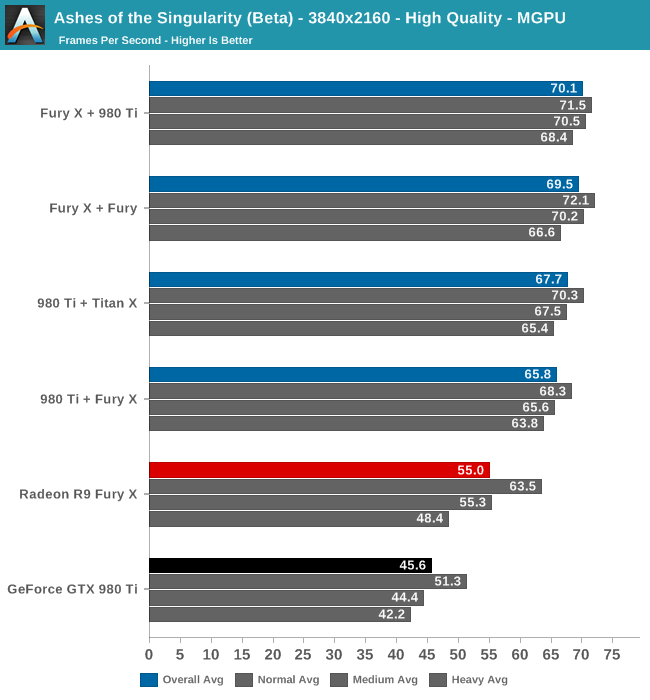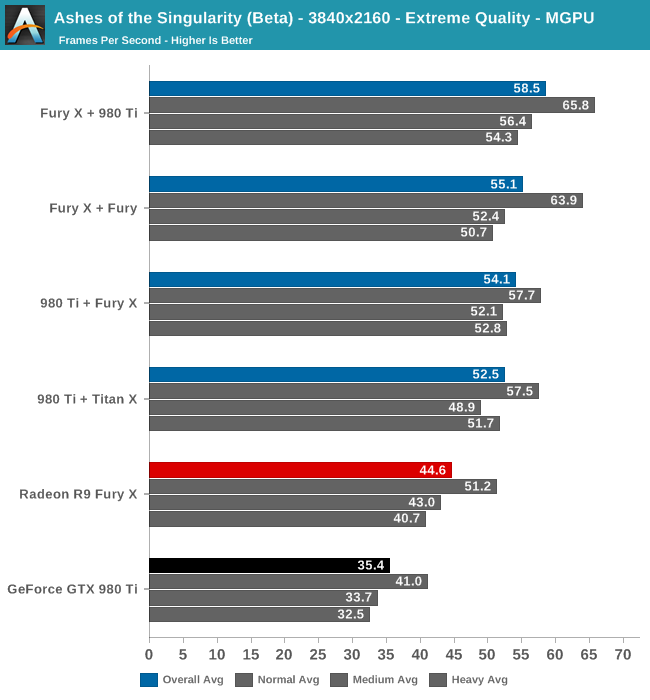Ashes of the Singularity Revisited: A Beta Look at DirectX 12 & Asynchronous Shading
by Daniel Williams & Ryan Smith on February 24, 2016 1:00 PM ESTDirectX 12 Multi-GPU Performance
Shifting gears, let’s take a look at multi-GPU performance on the latest Ashes beta. The focus of our previous article, Ashes’ support for DX12 explicit multi-GPU makes it the first game to support the ability to pair up RTG and NVIDIA GPUs in an AFR setup. Like traditional same-vendor AFR configurations, Ashes’ AFR setup works best when both GPUs are similar in performance, so although this technology does allow for some unusual cross-vendor comparisons, it does not (yet) benefit from pairing up GPUs that widely differ in performance, such as a last-generation video card with a current-generation video card. None the less, running a Radeon and a GeForce card together is an interesting sight, if only for the sheer audacity of it.
Meanwhile as a result of the significant performance optimizations between the last beta build and this latest build, this has also had an equally significant knock-on effect on mutli-GPU performance as compared to the last time we looked at the game.

Even at 4K a pair of GPUs ends up being almost too much at Ashes’ High quality setting. All four multi-GPU configurations are over 60fps, with the fastest Fury X + 980 Ti configuration nudging past 70fps. Meanwhile the lead over our two fastest single-GPU configurations is not especially great, particularly compared to the Fury X, with the Fury X + 980 Ti configuration only coming in 15fps (27%) faster than a single GPU. The all-NVIDIA comparison does fare better in this regard, but only because of GTX 980 Ti’s lower initial performance.
Digging deeper, what we find is that even at 4K we’re actually CPU limited according to the benchmark data. Across all four multi-GPU configurations, our hex-core overclocked Core i7-4960X can only setup frames at roughly 70fps, versus 100fps+ for a single-GPU configuration.

Top: Fury X. Bottom: Fury X + 980 Ti
The increased CPU load from utilizing multi-GPU is to be expected, as the CPU now needs to spend time synchronizing the GPUs and waiting on them to transfer data between each other. However dropping to 70fps means that Ashes has become a surprisingly heavy CPU test as well, and that 4K at high quality alone isn’t enough to max out our dual GPU configurations.

Cranking up the quality setting to Extreme finally gives our dual-GPU configurations enough of a workload to back off from the CPU performance cap. Once again the fastest configuration is the Fury X + 980 Ti, which lands just short of 60fps, followed by the Fury X + Fury configuration at 55.1fps. In our first look at Ashes multi-GPU scaling we found that having a Fury X card as the lead card resulted in better performance, and this has not changed for the newest beta. The Fury continues to be faster at reading data off of other cards. Still, the gap between the Fury X + 980 Ti configuration and the 980 Ti + Fury X configuration has closed some as compared to last time, and now stands at 11%.
Backing off from the CPU limit has also put the multi-GPU configurations well ahead of the single-GPU configurations. We’re now looking at upwards of a 65% performance boost versus a single GTX 980, and a smaller 31% performance boost versus a single Fury X. These are smaller gains for multi-GPU configurations than we first saw last year, but it’s also very much a consequence of Ashes’ improved performance across the board. Though we didn’t have time to test it, Ashes does have one higher quality setting – Crazy – which may drive a bit of a larger wedge between the multi-GPU configurations and the Fury X, though the overhead of synchronization will always present a roadblock.












153 Comments
View All Comments
Dug - Sunday, February 28, 2016 - link
Very bad would indicate that it would be unplayable.I'm playing fine at over 60fps on nvidia. Maybe I should trade it in for an R9 to get 63fps?
C3PC - Wednesday, March 16, 2016 - link
Not really, this is a beta for a game that is heavily embedded with AMD tech, the way the game handles it would favor AMDs implementation, it could go the other way for a game designed around Nvidia's implementation.Also, calling this bed performance of DX12? Maybe you should clarify that this is an implementation of 12_0 and not 12_1, I highly doubt AMD will fair as well as Nvidia under such circumstances.
jsntech - Wednesday, February 24, 2016 - link
For Nvidia to perform the same or worse between DX11 and DX12 seems like a pretty big thing to be addressed with just an 'optimization', especially compared to AMD's results. I guess we'll see when it's out of beta!Senti - Wednesday, February 24, 2016 - link
Well, being low-level DX12 leaves much less to driver, so there should be less miraculous fps gains by driver optimization than in DX11.mabellon - Wednesday, February 24, 2016 - link
Something I have been wondering about this game is whether the DX11 vs DX12 comparison is really valid. The game apparently pushes higher draw calls and takes advantage of DX12. But when running in DX11 mode, is it still trying to push all those unique draw calls or is it optimized like most DX11 games and using draw call instancing? (Sorry not a game dev, so I don't fully grok the particulars).Basically, if the game was designed and optimized for DX11 it might perform well but not have the visual fidelity of so many draw calls (unique unit visuals). So the real difference should have been visual quality. Instead I get the impression that the game was designed to push DX12 and then when in DX11 mode stresses the draw call limitations, over emphasizing the apparent gains. Am I wrong?
Currently it seems that porting a game from DX11 to DX12 nets up to a 50% improvement in framerates. The reality is more nuanced that existing games are clearly working around draw call limitations and thus won't see something quite so dramatic. Thoughts?
ImSpartacus - Wednesday, February 24, 2016 - link
I think you're probably right.Dx12 doesn't simply improve performance and nothing else. So the massive performance improvements probably aren't entirely fair.
extide - Wednesday, February 24, 2016 - link
It would have to use less draw calls for DX11 as hitting DX11 with the high number of calls you can do in DX12 would make it fall flat on it's face. I am sure the DX11 path is well optimised for DX11, I mean while this game is a big showcase for DX12, most people who play it will probably be on DX11 ...Denithor - Thursday, February 25, 2016 - link
People with nVidia cards will be playing in DX11 mode. People with AMD cards, even those three generations old, will be fine in DX12 mode with better eye candy and simultaneously better FPS.Friendly0Fire - Wednesday, February 24, 2016 - link
There's definitely quite a bit of that. Looking at the benchmark, a lot of the graphics design seems aimed at causing more draw calls (long-lasting smoke consisting of lots of unique particles, lots of small geometric details, etc.). While I'm absolutely convinced that DX12 will give better performance than DX11 in the long run and that the gap will be fairly large, I think this benchmark is definitely designed to overemphasize just how great DX12 is.jardows2 - Wednesday, February 24, 2016 - link
I would like to see how much of an impact the DX12 on a released game makes in the CPU world. Do you get better performance from multiple cores, or is it irrelevant? Speculation is that DX12 could change the normal paradigm for judging gaming performance on CPU's.